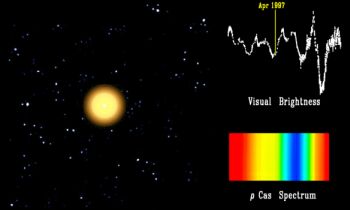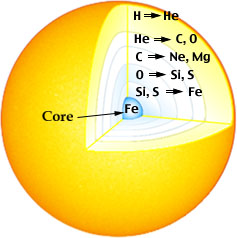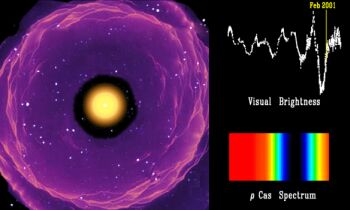Rho Cassiopeiae

Rho Cassiopeiae |

|
|
| Home | X-Objects | Stars | Habitability | Life | |
 David
A. Aguilar,
CfA
David
A. Aguilar,
CfA
Larger illustration.
Located around 10,000
light-years away, Rho
Cassiopeiae is a
sometimes reddish,
yellow hypergiant that
recently has been ejecting
about 5.4 percent of a
Solar-mass annually and
may be close to exploding
as a supernova (more from
CfA
and
Lobel
et al, 2003).
Yellow Hypergiants
Rho Cassiopeiae (Rho Cas) belongs to an unusual class of
stars called
hypergiants,
which are much brighter and many times more massive than Sol.
Despite being located some 10,000 light-years (ly) away, the
star is visible to the naked eye because it is over 500,000
times more luminous than Sol. Like all extremely massive stars,
however, hypergiants are very short-lived with a total life
of only a few million years. Rho Cas is a yellow hypergiant,
which are particularly rare objects as only seven (including
HR
8752 and
IRC+10420)
have been found in the Milky Way. With surface temperatures
between 3,500 and 7,000 °K, yellow hypergiants appear to be
stars that are at a very evolved stage of their life and may
be close to exploding as supernovae.
 Lobel
et al, 2003,
CfA
Lobel
et al, 2003,
CfA
Larger image from
animation.
Before its 2000-2001 eruption,
the star was a yellowish-white
hypergiant with a surface
oscillation of 320 days
(more).
 Lobel
et al, 2003,
CfA
Lobel
et al, 2003,
CfA
Larger image from
animation.
During 2000-2001, the star's
outer gas envelope contracted
then expanded, brightening
then dimming and reddening
over several months
(more).
In theory, hydrogen-fusing dwarf stars of 10 to around 60 Solar-masses first evolve as spectral type O to become blue supergiants and then progress to become red supergiants (type M). Stars with 30 to 60 Solar-masses then "loop back" from swollen and cooler, red supergiant phase back into much hotter but smaller blue supergiants (Stothers and Chin, 2001); in contrast, those starting with more 60 Solar-masses remain as blue supergiants. Rho Cas appears to be changing back from being a red supergiant, when it may have been five times larger (James Kaler, 2002; Israelian et al, 1999; and Cornelius de Jager, 1997). In which case, Rho Cas may be "bouncing against" the Yellow Evolutionary Void where such stars become unstable -- as evidenced by its high, if irregular, variability -- and soon explode as a Type-II supernova (like Supernova 1987 A).
 NASA
Observatorium
NASA
Observatorium
Some astronomers believe
that Rho Cas may soon run
out of core nuclear fuel
and become a supernova.
See a discussion of "the
Burning
of Elements Heavier
than Helium" and
"Supernova
Explosions" as part of
stellar
evolution and death.
Rho Cassiopeiae
Based on estimates of interstellar absorption and absolute visual magnitude, Rho Cassiopeiae may be located around 10,100 +/- 1,600 ly from Sol (Lobel el al, 2003). It lies in the southwestern part (23:54:23.0+57:29:57.8, ICRS 2000.0) of Constellation Cassiopeia, the Lady of the Chair -- southwest of Caph (Beta Cassiopeiae), south of Tau Cassiopeiae, north of Sigma Cassiopeiae, northwest of Schedar (Alpha Cassiopeiae), and east of M52, the Bubble Nebula, and Delta Cephei. It is located in the Cassiopeia OB5 Association (James Kaler, 2001).
The star is a slowly pulsating, post-main sequence yellow hypergiant of spectral and luminosity type F8-G2 Ia0pe, with an atmospheric abundance of Nitrogen and Sodium and strong emission lines of Iron (Fe I), Nickel (Ni I), and Calcium (Ca I). It may have around 40 Solar-masses (James Kaler, 2002). According to Robert Burnham, Jr. (1931-93), the star ranges in brightness from a normal range of magnitude of 4.4 to about 5.1 but dimmed to 6th magnitude on 1946. Although no real periodicity has been evident, the interval between some peaks has been around 100 days. When near maximum, its spectral type has been classified as F8, but the light is redder than normal for a F-type star. When varying in brightness, its spectral type has fluctuated between F8 and K5, and reached M5 in June 1946, mostly through atmospheric cooling rather than dimming (James Kaler, 2002). While its spectrum appears to be that of a supergiant, its luminosity is around 100 times greater.
 Gabriel
Pérez Díaz,
Gabriel
Pérez Díaz,
Instituto
de Astrofísica de Canarias
Larger illustration.
During its 2000-2001 eruption, Rho Cas
ejected about 10 percent of a Solar-
mass, dimmed by more than a full
magnitude, and changed its spectral
type from late F to early M (more
from
ING
and
Lobel et al,
2003).
Neither a cool red or a hot blue like most hypergiants, Rho Cassiopeiae is particularly unusual. With a surface temperature of around 7,300 °K, it radiates substantially in visible light. The star has an absolute bolometric magnitude of -9.6, radiating with a luminosity of about 550,000 times that of Sol. It appears to have a diameter between 400 and 500 times Sol's, where at 450 times the Solar diameter it would extend 4.3 AU or about 40 percent more than the orbit of Mars (James Kaler, 2002; and Alex Lobel, 2001). The star is emitting a 10-km-per-second stellar wind that is ejecting around 5.4 percent of a Solar-mass of its gas and dust annually (Lobel et al, 2003). It is classified as a variable star (Percy et al, 2000). Useful catalogue numbers and designations for this star include: Rho Cas, 7 Cas, HR 9045, HIP 117863, HD 224014, BD+56 3111, SAO 35879, FK5 899, and SV* HV 194.
 Lobel
et al, 2003,
CfA
Lobel
et al, 2003,
CfA
Larger image from
animation.
After the star dimmed,
dark bands in its spectrum
appeared indicating that
molecules such as Titanium
Oxide formed as its outer
atmosphere cooled
(more).
During the recent 2000-2001 eruption, Rho Cas brightened briefly, then dimmed for a period of months. Astronomers believe that the initial brightening occurred because gases fell in towards the star and were compressed and heated. Subsequently, some of that material was blasted outward in a powerful, circumstellar shock wave, which dimmed the star by a factor of six (from 4th to 6th magnitude) and altered its spectral type from F to M, indicating a drop in surface temperature from 12,000 °F (7,000 °K) to 5,000 °F (3,000 °K). As when Rho Cas dimmed around 1945-46 and 1985-86, dark bands appeared in the optical spectrum of Rho Cas, indicating that molecules not normally present (particularly that of titanium oxide) were able to form in the star's cooler outer atmosphere (Lobel et al, 2003). Rho Cass ejected unusually high amounts of mass in 1893 and around 1945-47 that appeared to be associated with a decrease in surface temperature and the formation of a dense envelope, which suggest that the star has a major eruption about once every 50 years and that the current eruption is leading to such an extreme event.

Gabriel Pérez Díaz,
Instituto
de Astrofísica de Canarias
Another animation
of the
star's recent eruption.
More discussion
and images.
Since its eruption in 2000, the star's atmosphere has been pulsating in a strange manner. Its outer layer now seems to be collapsing again, as occurred prior to the last outburst. As a result, astronomers believe that an even larger eruption may be imminent (AAS, 2003).
Other Information
See astronomer Alex Lobel's web page which has more images, animations, a presentation slideshow, a paper and other references, and a press release on Rho Cassiopeiae. Try also Professor Jim Kaler's Stars site for other information about Rho Cassiopeiae at the University of Illinois' Department of Astronomy.
Up-to-date technical summaries on this star are available at: NASA's ADS Abstract Service for the Astrophysics Data System; and the SIMBAD Astronomical Database mirrored from CDS, which may require an account to access.
With its stars shaped in a "W," the northern Constellation Cassiopeia was named by the Ancient Greeks for the mother of Andromeda who claimed to be more beautiful than the daughters of Nereus, a god of the sea. Cassiopeia's vanity so angered the sea god Poseidon that he had Andromeda chained to a rock of the coast as a sacrifice for Cetus (the monstrous whale) until Perseus rescued her. For more information on stars and other objects in this Constellation and a photograph, go to Christine Kronberg's Cassiopeia. For an illustration, see David Haworth's Cassiopeia.
For more information about stars including spectral and luminosity class codes, go to ChView's webpage on The Stars of the Milky Way.
© 2003 Sol Company. All Rights Reserved. |